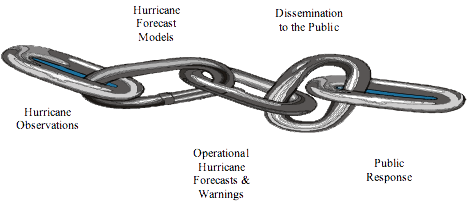Hurricane forecasting requires a coordinated effort that involves five main components:
Observations from satellites, reconnaissance aircraft, ships, buoys, radar, and other land-based platforms are the basis for all forecast and warning products issued by NOAA’s National Hurricane Center (NHC) and other worldwide hurricane forecast centers (see Hurricane Observations). These observations are checked for quality, analyzed, and fed into a suite of computer models (see Hurricane Forecast Models). Results from the hurricane forecast models are interpreted and used as guidance for the appropriate forecast centers and local weather offices to help them issue official hurricane forecasts and warnings. It is the timely and reliable dissemination of these forecast and warning products that allows members of the public (and their local emergency managers) to make plans to secure their property and take other necessary measures to protect themselves in the days and hours prior to a hurricane (or tropical storm) landfall (see Hurricane Preparation, Response, Recovery and Risk Mitigation). The pages to follow contain more details on who issues operational hurricane forecast and warning products, what these products are, and how these products are disseminated to the public.
Hurricane Forecasting
|


